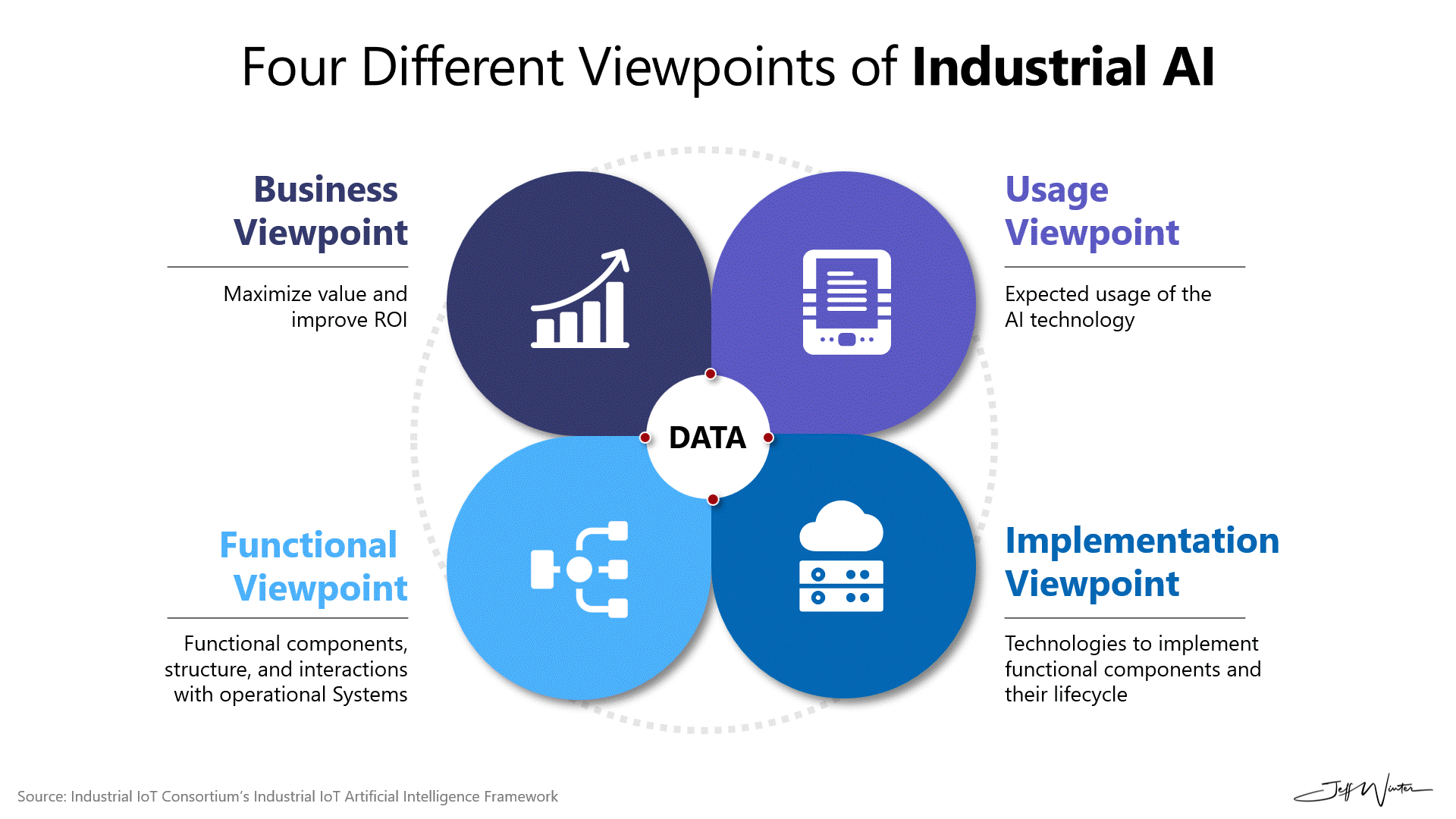Four Different Viewpoints of Industrial AI
The Industrial AI Framework, developed by Industry IoT Consortium in 2022, is a useful 59-page guide for integrating artificial intelligence (AI) within industrial Internet of Things (IIoT) systems. The framework provides organizations with valuable insights into how AI can improve efficiency, safety, decision-making, and business outcomes in areas like manufacturing, robotics, and predictive maintenance. It helps businesses adopt AI technology to uncover insights from complex data, enable digital transformation, and prepare for future challenges by leveraging AI’s potential to optimize operations and create new business models.
My favorite part about this framework is it describes four different viewpoints that help frame concerns and guide AI adoption in industrial systems:
Business Viewpoint: This focuses on maximizing value and improving return on investment (ROI) by leveraging AI to extract insights from large data sets, enabling digital transformation, and future-proofing organizations. AI can enhance production efficiency, lower costs, and provide new capabilities for businesses.
Usage Viewpoint: Here, the focus is on how AI systems are used, with attention to trustworthiness, security, privacy, and ethical concerns. It also covers societal impacts and use cases in the industrial AI market.
Functional Viewpoint: This covers the technical structure and interaction of AI components within an IIoT system. It focuses on how AI models are built and deployed to solve industrial problems, including learning techniques and data management.
Implementation Viewpoint: This addresses practical considerations for deploying AI in industrial environments, such as reliability, response time, bandwidth, and security. It ensures that AI systems can be efficiently integrated and maintained.
Using the Framework in 2024
A lot can happen in just two years, and in the world of AI, those years feel like a leap forward. While this Industrial AI Framework remains extremely valuable as a foundation, the rapid advancements in AI have created new opportunities and challenges that weren’t fully addressed when this document was first created. The framework was, and still is, a solid guide for integrating analytical AI within Industrial IoT (IIoT) systems, helping organizations optimize operations, improve decision-making, and unlock hidden value in their data. It touches on key concerns like data management, system architecture, security, ethics, and deployment strategies. But in 2024, to stay relevant and future-proof, it needs to be broadened to reflect the realities of today’s AI landscape.
One of the most significant changes since 2022 has been the explosive growth of Generative AI. Unlike the AI discussed in this framework, which focuses on analyzing historical data to predict outcomes or optimize existing processes, Generative AI can create new content, designs, and solutions. This ability shifts AI from being purely analytical to becoming an engine for innovation. For example, Generative AI can not only predict when a machine might fail (as analytical AI would) but also generate multiple solutions for preventing that failure or even suggest new designs for more efficient machinery.
Much of the core architecture, data governance, and ethical considerations still apply. But updating the framework to reflect Generative AI would broaden its scope significantly. Here’s how AI leaders can leverage what’s already built while enhancing it for today’s capabilities:
Broaden the Scope: The original framework focuses specifically on IIoT systems. Updating it to include all operational systems across industries, not just industrial settings, would make it more flexible. Generative AI can be applied to areas like supply chain management, healthcare, and even retail, where its ability to create new solutions can drive transformative change.
Integrate Generative AI: Leaders should build upon the analytical AI models described in the document by incorporating Generative AI for tasks like product design, system optimization, and scenario planning. For instance, in manufacturing, Generative AI can simulate various production processes and generate designs for machinery or products that are more efficient or cost-effective.
Update Ethical and Trustworthiness Guidelines: With Generative AI’s ability to produce new content autonomously, the framework’s sections on trustworthiness and ethics will need to evolve. Leaders should expand on the original guidelines, ensuring that issues like bias, explainability, and misuse of AI-generated content are addressed. Transparency and user control will become even more critical as AI moves from making decisions to creating solutions that could significantly impact operations.
Data and Compute Infrastructure: Generative AI often requires far more computational power and data than traditional models. AI leaders should enhance the Implementation Viewpoint to include guidance on the increased infrastructure demands for deploying Generative AI. Considerations for storage, processing, and real-time data generation will be crucial in industries where AI is integrated directly into physical operations, like autonomous vehicles or robotics.
Use Cases and New Applications: The framework already discusses AI use cases like predictive maintenance and smart manufacturing. Leaders can take this further by adding Generative AI applications, such as creating simulations for future scenarios, generating optimized supply chain routes, or even producing creative marketing content based on business data. These new use cases will highlight the expanding role of AI beyond traditional optimization
References:
Industry IoT Consortium, Industrial Artificial Intelligence Framework, 2022: https://www.iiconsortium.org/2022/03/a-framework-for-industrial-artificial-intelligence/

